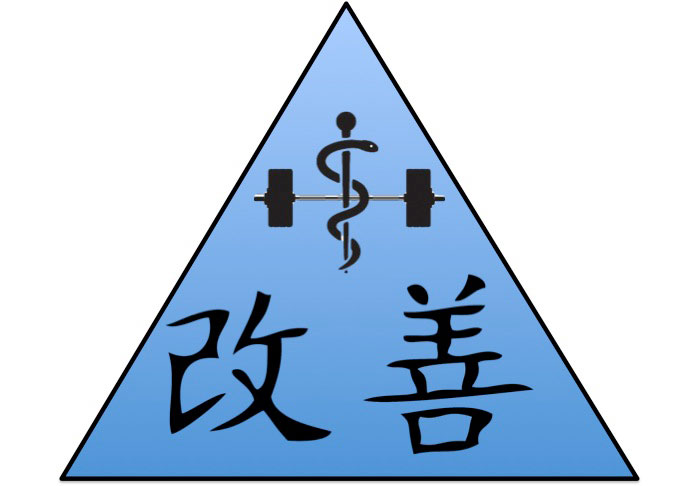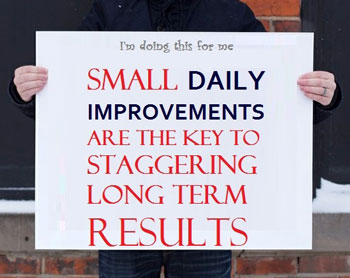
Strong Medicine has over six hundred pages of text and illustrations that will dramatically change how you perceive nutrition, training, and how you can effectively manage the stressors in your lifestyle. The concepts and how they can be applied are laid out in such a manner that, with the some simple planning, discipline and implementation, you will have no choice but to be successful. This blog post is going to provide you with some tools and strategies that you can use in order to implement the concepts presented in Strong Medicine in such a way that you will not only succeed, but will be able to do so with the least amount of stress possible.
Change… Sucks!
Making drastic changes in your life does not lead to dramatic results–it usually leads to dismal failure and a lot of brow beating! Anyone who has made a New Year’s resolution only to have it crumble within a matter of weeks (or in some cases, a matter of hours) knows that making changes (big or small) in your life is hard to do. Everyone starts out with good intentions and a wealth of willpower only to see the good intentions crumble and the willpower dissolve like a puff of smoke at the first impasse. With all of these bad past experiences surrounding change, I’m sure you’re convinced that you can’t make any changes in your life and might as well just quit now. Wrong! Just because you failed in the past doesn’t mean you’ll fail this time–especially if you are honest with yourself about the plans and tools you need to succeed. So… how do you begin making changes? The same way you’d eat an elephant–one bite at a time!
Kaizen = Continual Improvement 
Kaizen is a Japanese term that has been borrowed by the business world. Roughly translated, it means “change for the better” or “continual improvement”. As a business major in college (many, many, many years ago) I learned about the concept of “Kaizen” and how it was successfully implemented in the Japanese automotive industry. Kaizen gave everyone–from the guy sweeping the floor to the VP in charge of making million dollar decisions–the power to change how things were done on a daily basis. In other words, the power was placed in the hands of those who could make the most difference. Since then, the concept of Kaizen has been applied to banking, healthcare, government and other areas where complicated processes need to be considered and improved to increase efficiency and consistent outcomes.
How does this apply to you and how will it impact the implementation of what you’ve learned from Strong Medicine? You need to develop a simple but effective plan for implementing the nutritional and training guidelines presented in Strong Medicine. Your plan should be created and executed in a way so that changes can be small, easily managed, and built upon. Remember that the best plans are the simplest effective ones that also have the latitude for change and modification on the fly.
NOTE: Understand that these plans are best implemented one at a time. Trying to make too many changes too soon and with too much accompanying stress will make this process a lot harder than necessary. With this in mind, I feel that the concepts behind Kaizen are the best common-sense approaches to implementing any nutrition, training or lifestyle modifications.
“Eat like an Adult”
Strong Medicine goes into great detail about what and how you should eat–and how those choices are will effect you over the short and long term. There are many scientific theories and big words involved–which can be daunting to some people–but you will need to absorb it to understand what Dr. Chris and Marty are trying to do. They successfully make many complex ideas and concepts simple to grasp, and that’s vitally important for the subjects of nutrition and training. I admire people who can take complex problems and explain solutions in simple terms everyone can understand. For example, when Dan John said, “Eat like an Adult” during a lecture a couple years ago, it really stuck with me. His comment was simple, direct and to the point. Those four words make choosing, preparing, and eating the right foods a lot easier! I know those four words help me get in the right mindset when I’m preparing, ordering, and even shopping for food.
Start with the Beginning 
“Eating like an Adult” will help you succeed with the Strong Medicine guidelines. But first you need to know where you stand. The easiest (and the most eye-opening) method I know is to keep a food log for ten days. (Before you start grumbling and groaning, hear me out–the food log will give you some great intel into what’s going on and how to fix it!) Keeping a food log is as simple as folding a piece of paper into sections, then writing down everything that goes in your mouth. Breakfast, lunch, dinner, snacks, drinks, etc.–it all goes in the food log. Once you have all this information you’ll be able to create a baseline for what kind of food you are eating, how much you are eating, and what is missing from your diet. Remember, keep this as simple as possible and don’t stress out about what you are writing down. It’s just information you’ll use to create a plan!
Once you have ten days of information, what do you do with it? First, find the gaps in your nutrition. For example you might notice that during those 10 days the only time you ate any vegetables (not counting the lettuce and tomato on your hamburger) was with dinner. Over ten dinners you had a handful of salads, a couple baked potatoes (not to mention French fries), and several servings of broccoli. If that was the case, then introducing more vegetables into your evening meals AND including them as part of breakfast and lunch would be in order.
Getting Started
Does this sound like a big step and a major hassle? Not really! It just takes a little forethought and preparation and you’ll have it nailed. Prepare by having the food you need on hand, and by creating and using shopping lists. Your shopping list will guide you through the grocery store. For the most part you’ll stay in the periphery, where the vegetables, meat and dairy products are found. (Stay away from the middle of the store where the Mountain Dew and Fritos are located!) Grab your list and shop either once a week or several times a week, whichever is more comfortable or convenient for you. Remember, you’re only shopping for the things on your list! NOTE: if you don’t have a shopping list, you can Google “shopping list” for plenty to choose from and modify as needed.
Now that you have all this food in the kitchen, what do you do with it? Well, you will need to start making your own meals based on the nutrition gaps in your food log. It will be easy for the most part–in the above example, we simply need to increase the amount of veggies throughout the day. We need to make this change as simple as possible. Think about this: it only takes a minute or two to cut up some peppers or cucumbers and throw them into a plastic bag or Tupperware for later in the day. Grab some veggies and prep them for the day while you’re standing around waiting for your coffee to brew in the morning!
I can hear the whining and moaning already! “Veggies for breakfast and lunch? How am I going to do that?” Easily! Just add vegetables you like to meals you are already eating. Still confused? Here’s some ideas to help you jump start the process!
How to add vegetables to breakfast:
- Add avocado and salsa to your scrambled eggs
- While frying your eggs, sauté some spinach in bacon grease and serve it on the side or as a bed for the eggs
- Warm up some sauerkraut for a tangy side (or kimchi for something spicy) with your eggs
- Brown onions, tomatoes and mushrooms and make an omelet
- Slice up some hard boiled eggs with ripe tomatoes
- Slice red or yellow peppers, clean out any seeds and whatnot. Put the slices in a frying pan and add an egg inside the gap for peppers and eggs over easy
- Grab a container full of sliced veggies (that you prepared the night before) and a container of yogurt for a quick and easy breakfast on the go
- Chop bacon into bite-size pieces and toss them in a frying pan. Add onions and peppers then simmer everything together. Drain the excess oil, then toss the bacon and vegetables on top of scrambled or poached eggs
Small Steps Lead to Big Results
I guarantee that if you take a little time and mental energy and apply it to filling in the gaps of your nutrition, it will pay huge benefits in the short and long term. I’m not proposing massive changes. On the contrary, I think the best and most effective way to ensure your success is by making small changes that you can easily adjust to before moving onto the next step. Remember what you learned in Strong Medicine about how stress (in all its forms) adversely affects the body. Adding stress by making big changes in your nutrition will be counter-productive. Keep the concepts of Kaizen in the forefront of your mind–small changes leading to big results–and you will not stress out at all!
NOTE: The training for life guidelines will be in part two of this blog post. In the meantime, I want you to start improving your nutrition. Small increases in nutrients will have a major impact on how you feel and move. By getting your nutrition plan in place now, you will establish the foundation for a successful training program.
***
Michael Krivka is a Senior RKC with Dragon Door and has been training with, teaching, and sharing the gospel of the kettlebell for over a decade. As a life-long martial artist, he is a Full Instructor under Guro Dan Inosanto in Jeet Kune Do (JKD); the Filipino Martial Arts of Kali, Escrima and Arnis; and Maphilindo Silat. He lives in Gaithersburg, Maryland with his wife and two sons. He owns CrossFit Koncepts where he runs strength and conditioning classes with an emphasis on kettlebell training, mobility and longevity. Follow him on Facebook.com/CrossFitKoncepts or Instagram.com/Michael_Krivka
Editor’s Note:
Where the Strong Medicine book is the template for lifestyle change and taking charge of your health, Mike has the beginnings of a Strong Medicine Operational Manual with this first post. The philosophy of Kaizen melds so well with our philosophy of lifestyle change that I am kicking myself for not including it the book, but this is why I try to surround myself with talented people like Mike Krivka.
In keeping with the mission of the blog for a two-way exchange of information, please share your perspective on lifestyle change in keeping with the Kaizen philosophy. Fantastic job, Mike!